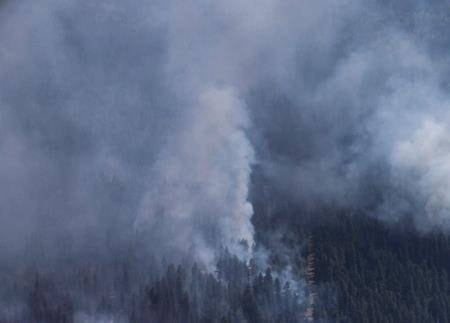Unprecedented smoke from B.C.’s wildfires in 2017 is helping scientists model the potential impacts of nuclear war on the Earth’s climate, says a study from Rutgers University.
The enormous plume of smoke formed the largest cloud of its kind ever observed, which circled the Northern Hemisphere, says the study published Thursday in the peer-reviewed academic journal Science.
The cloud, called a pyrocumulonimbus, formed over the wildfire and sent black carbon high into the atmosphere, said the study’s co-author Alan Robock, a distinguished professor in the department of environmental sciences at Rutgers in New Jersey.
The scientists used a climate model from the National Center for Atmospheric Research in the U.S. to forecast the movement of the dark cloud high into the Earth’s stratosphere, where there is no rain, Robock said.
“This smoke that lofted up, that’s what our climate models told us would happen if we put smoke in (the model) as a result of fires from burning cities and industrial areas as if there was a nuclear war,” said Robock.
The smoke lasted more than eight months in the stratosphere, where there is no rain to wash it away, the study said.
When soot heats up and extends higher into the stratosphere, the process is known as self-lofting, it said.
“We had never observed it actually happen,” said Robock. “This natural occurrence validated what we had done before in our climate models, so it gave us more confidence that what we were doing was correct.”
The team of researchers, including Robock, plugged the data from the B.C. wildfires into their software and successfully compared the real and the projected results, validating their ongoing climate modeling.
Robock has been studying and modeling the potential impacts of a so-called nuclear winter since 1984. Even a relatively small nuclear war between India and Pakistan would, for example, send soot into the stratosphere, causing unprecedented climatic cooling, he said.
“The temperatures wouldn’t get below freezing in the summer like they would with a war between the United States and Russia. But it would still have devastating effects on agriculture around the world, far removed from where the bombs were dropped,” said Robock, who added that global cooling as a result of nuclear war is by no means a solution to the global heating occurring today.
FROM 2017: Five before-and-after photos of the B.C. wildfire smoke
In the case of nuclear winter resulting from a nuclear war between large superpowers, Robock said temperatures would dip below freezing in the summertime and stay there for years, causing starvation as agriculture grinds to a halt around the world.
The wildfire smoke cloud contained 0.3 million U.S. tons of soot, while a nuclear war between the United States and Russia could generate 150 million tons, Robock said.
READ MORE: App converts B.C. air quality to cigarettes smoked
Brenna Owen, The Canadian Press
